The Evolution of Staking Infrastructure
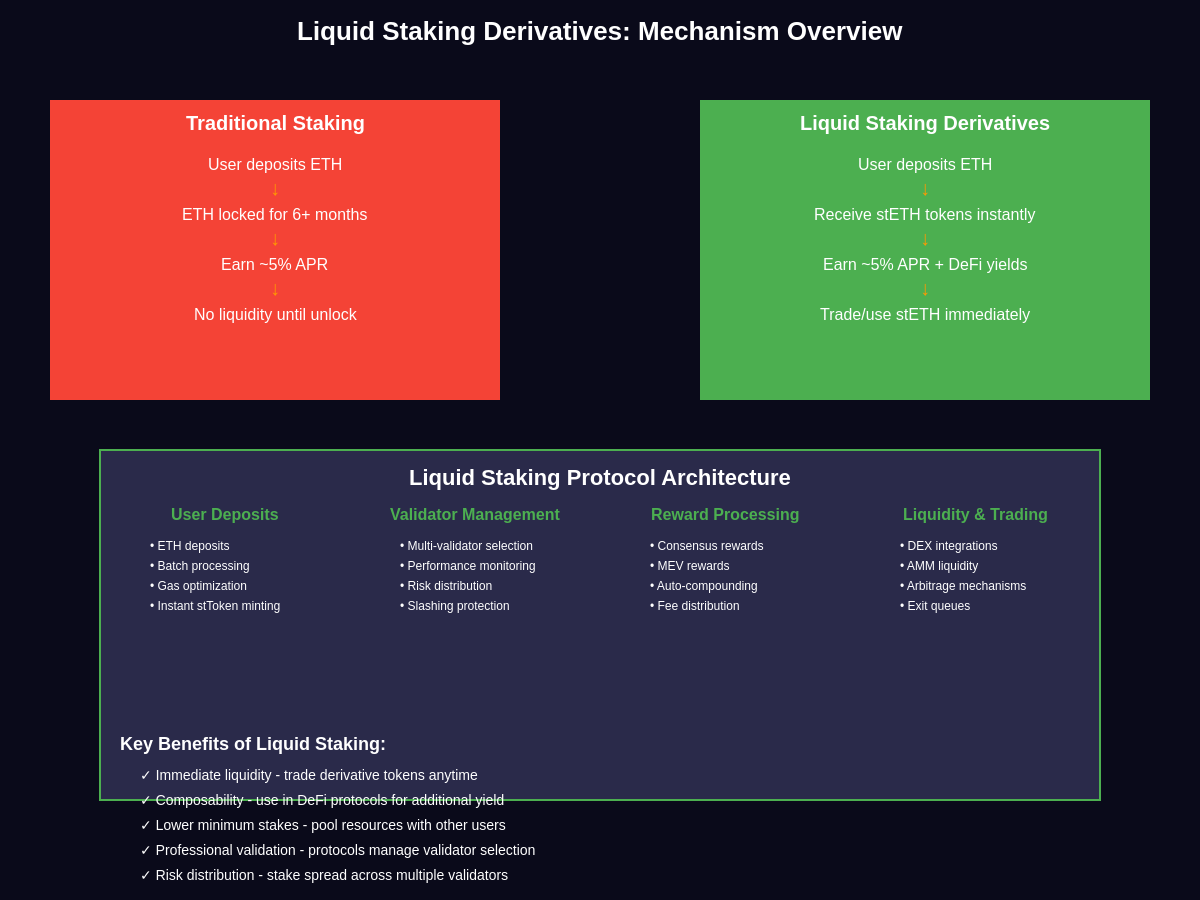
The transition from proof-of-work to proof-of-stake consensus mechanisms has fundamentally transformed how blockchain networks secure themselves and how investors participate in network validation. Ethereum’s successful merge to proof-of-stake in September 2022 marked a pivotal moment that catalyzed widespread adoption of staking as a primary method for earning yield on cryptocurrency holdings. However, traditional staking presented a significant limitation that liquid staking derivatives have ingeniously solved, enabling users to maintain liquidity while earning staking rewards.
Traditional staking requires users to lock their tokens for extended periods, typically ranging from weeks to months depending on the network’s unbonding period. During this lock-up period, staked assets become illiquid, preventing holders from participating in other yield-generating activities, trading opportunities, or responding to market volatility. This liquidity constraint created a substantial opportunity cost that deterred many potential stakers from participating in network security, ultimately limiting the economic efficiency of proof-of-stake networks.
Liquid staking derivatives emerged as an elegant solution to this liquidity problem, allowing users to stake their tokens while receiving tradeable derivative tokens that represent their staked position. These derivative tokens, often prefixed with “st” or suffixed with “ETH” for Ethereum-based protocols, maintain a relationship with the underlying staked assets while providing immediate liquidity. Professional traders monitoring Ethereum staking yields and liquid derivative performance can observe how these instruments have created new opportunities for yield optimization and capital efficiency.
The mechanism underlying liquid staking derivatives involves sophisticated smart contract systems that manage the staking process on behalf of users while issuing corresponding derivative tokens. When a user deposits tokens into a liquid staking protocol, the protocol stakes those tokens with one or more validators and mints derivative tokens representing the user’s claim on the staked assets plus accumulated rewards. These derivative tokens can be traded, used as collateral in DeFi protocols, or held to earn staking rewards, effectively eliminating the opportunity cost traditionally associated with staking.
Protocol Architecture and Validator Selection
Liquid staking protocols employ complex validator selection and management strategies to optimize returns while minimizing risks associated with validator performance and potential slashing events. Leading protocols like Lido, Rocket Pool, and Frax implement sophisticated algorithms that distribute staked assets across multiple validators to reduce concentration risk and ensure consistent reward generation. This distribution strategy is crucial because validator performance directly impacts the yield earned by derivative token holders, making effective validator management a core competency for liquid staking protocols.
The validator selection process typically considers multiple factors including historical performance, commission rates, uptime statistics, and slashing history. Advanced protocols implement dynamic rebalancing mechanisms that can redistribute stake away from underperforming validators toward those demonstrating superior reliability and yield generation. This active management approach distinguishes liquid staking protocols from individual staking, where users must personally research and select validators while bearing the full risk of their chosen validator’s performance.
Smart contract architecture plays a fundamental role in ensuring the security and efficiency of liquid staking operations. Protocols must carefully design their contracts to handle validator deposits, withdrawal queues, reward distribution, and the minting and burning of derivative tokens. The complexity of these operations requires extensive security audits and formal verification processes to prevent vulnerabilities that could result in loss of user funds or protocol exploitation.
Risk management extends beyond technical considerations to include economic and governance risks. Liquid staking protocols must maintain sufficient liquidity reserves to handle withdrawal requests during periods of high demand while optimizing the percentage of assets actively staked to maximize yield generation. Analyzing liquid staking protocol performance and total value locked metrics helps investors understand how different protocols balance these competing objectives and manage their operational risks.
Yield Optimization Strategies and Compound Returns
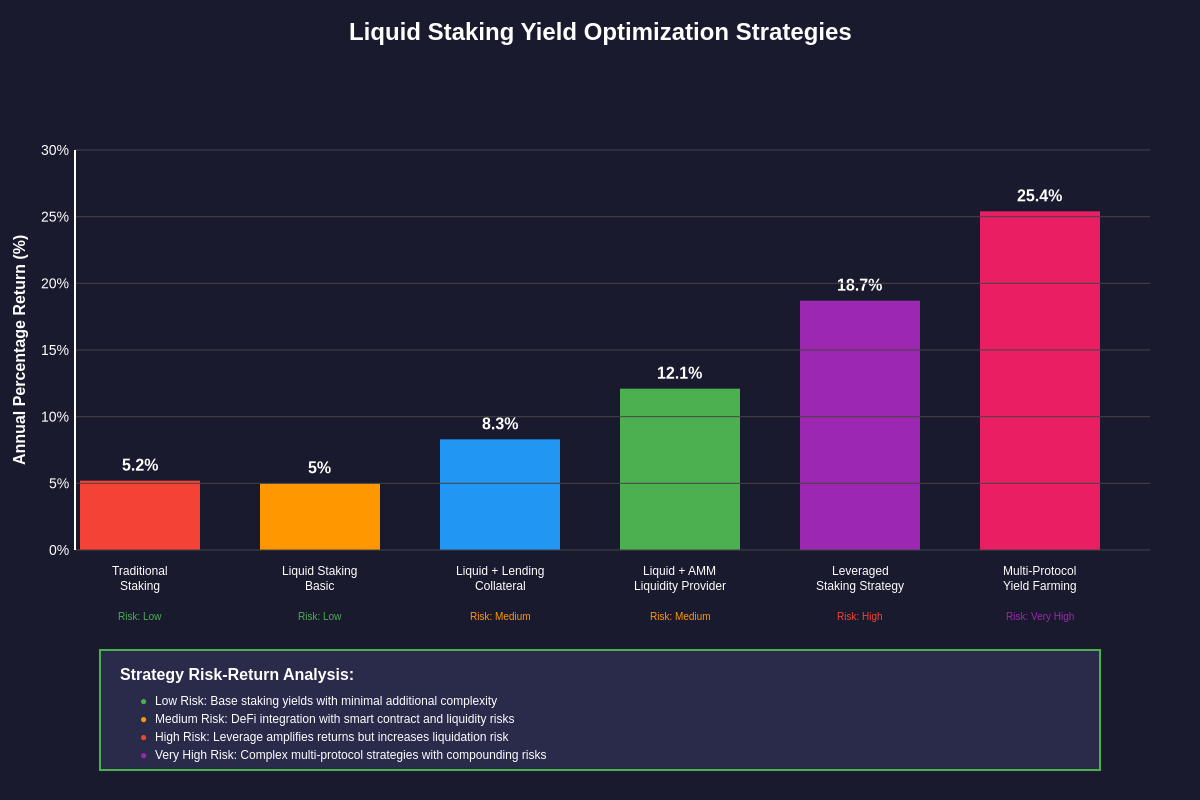
Liquid staking derivatives unlock sophisticated yield optimization strategies that would be impossible with traditional staking approaches. The tradeable nature of these derivatives enables users to implement multi-layered yield generation strategies that can significantly enhance overall returns. Base staking yields, typically ranging from 3-7% annually depending on the network and staking participation rates, serve as the foundation for more complex yield optimization approaches.
The most straightforward optimization involves using derivative tokens as collateral in lending protocols to borrow additional assets for further staking or yield farming activities. This leverage strategy can amplify returns when implemented carefully, though it also introduces additional risks including liquidation risk and smart contract vulnerabilities. Sophisticated users employ various risk management techniques including position sizing, diversification across multiple protocols, and dynamic adjustment of leverage ratios based on market conditions and yield spreads.
Automated yield optimization protocols have emerged to simplify these complex strategies for retail users. These protocols automatically compound staking rewards, reallocate assets to higher-yielding opportunities, and manage the operational complexity of multi-protocol interactions. Some advanced systems implement machine learning algorithms that analyze historical yield patterns, market conditions, and protocol parameters to optimize allocation decisions and maximize risk-adjusted returns.
Comparative analysis reveals significant return enhancement potential through liquid staking derivative strategies. While traditional staking might generate 5% annual returns, optimized liquid staking strategies can achieve 8-15% or higher, depending on market conditions and the specific strategies employed. However, these enhanced returns come with correspondingly increased complexity and risk, requiring users to carefully evaluate the trade-offs between potential returns and associated risks.
DeFi Integration and Composability Benefits
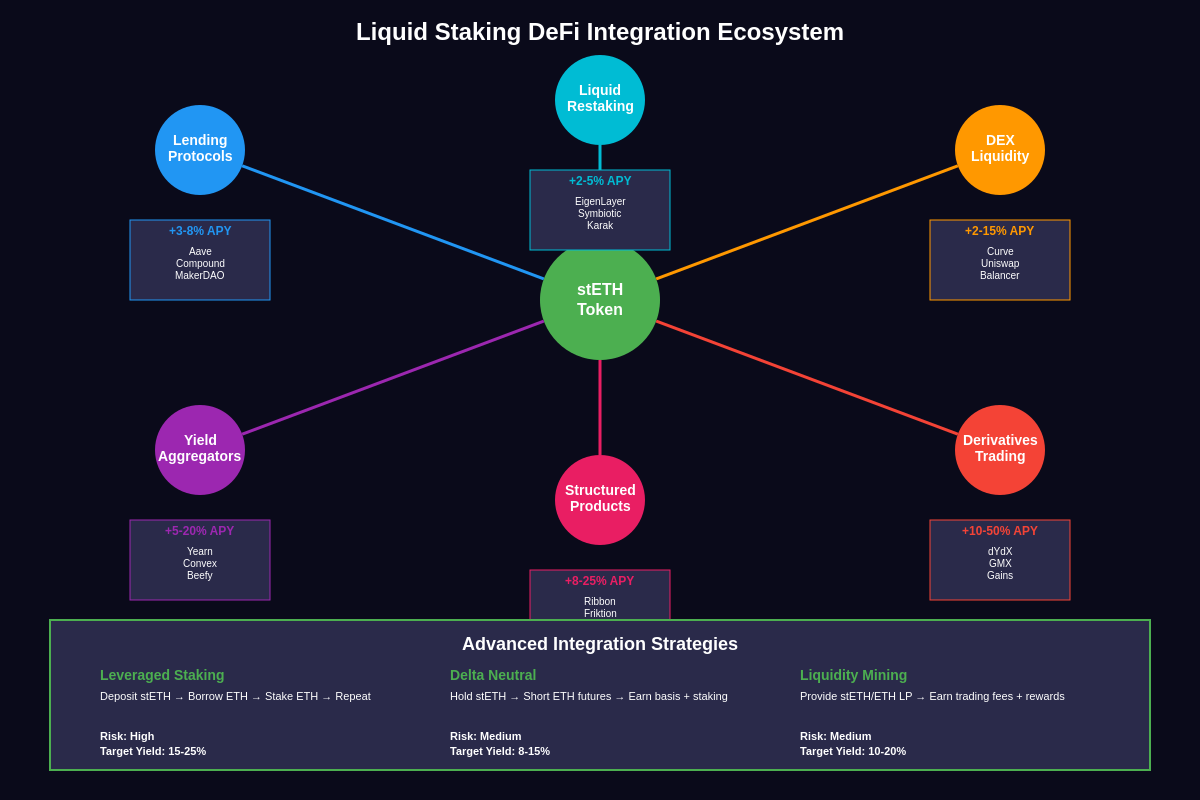
The composability of liquid staking derivatives with broader DeFi ecosystems represents one of their most compelling value propositions. These tokens seamlessly integrate with lending protocols, automated market makers, yield aggregators, and other DeFi primitives, enabling users to access sophisticated financial strategies previously available only to institutional investors. This composability effectively transforms staked assets from idle capital into productive components of complex financial strategies.
Lending protocol integration allows users to deposit derivative tokens as collateral to borrow other assets, creating opportunities for leveraged staking, arbitrage strategies, and portfolio diversification without liquidating staked positions. Popular lending protocols like Aave, Compound, and Maker have integrated support for major liquid staking derivatives, recognizing their stability and yield-generating characteristics as valuable collateral assets.
Automated market maker integration enables deep liquidity for derivative tokens, allowing users to trade their staked positions with minimal slippage and transaction costs. Curve Finance, Balancer, and Uniswap maintain substantial liquidity pools for liquid staking derivatives, providing efficient price discovery and trading mechanisms. These liquidity pools often offer additional yield through trading fees and liquidity mining rewards, creating multiple income streams for derivative holders.
Advanced DeFi strategies leverage these integrations to create sophisticated yield optimization systems. For example, users might deposit derivative tokens into a lending protocol, borrow stablecoins against this collateral, use those stablecoins to purchase additional staking tokens, stake those tokens for more derivatives, and repeat this process to achieve leveraged exposure to staking yields. Traders utilizing advanced DeFi analytics and yield tracking tools can model these complex strategies and monitor their performance across multiple protocols and market conditions.
Risk Assessment and Mitigation Strategies
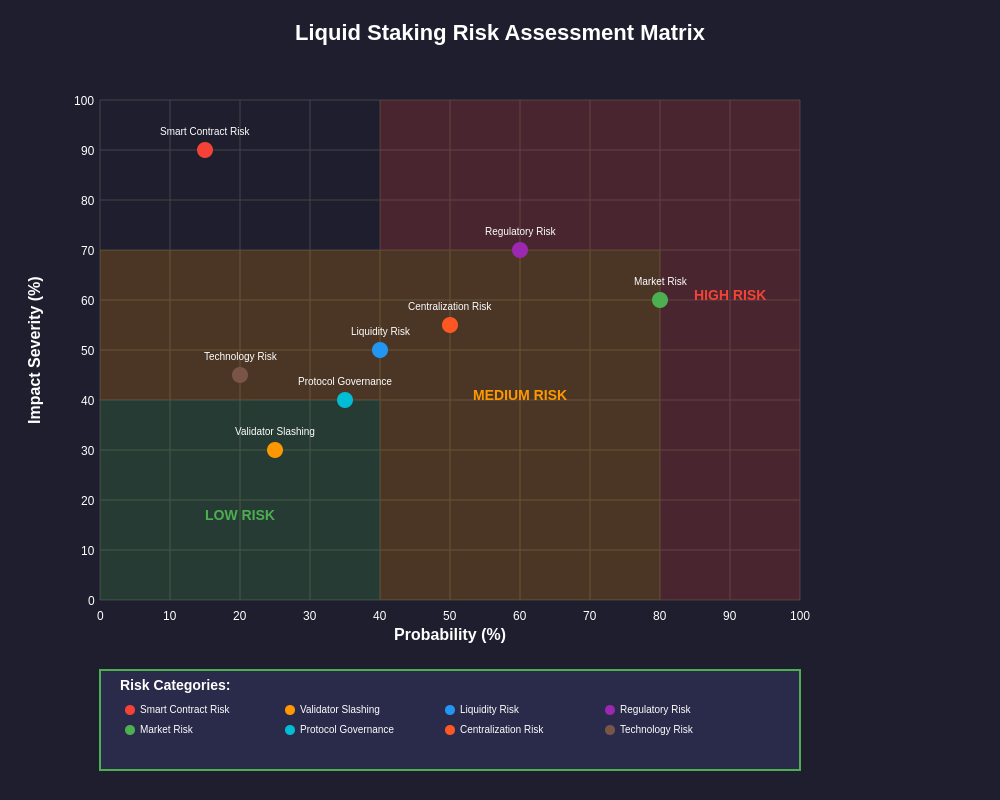
While liquid staking derivatives offer compelling benefits, they introduce unique risk vectors that users must carefully evaluate and manage. Smart contract risk represents the most fundamental concern, as these protocols rely on complex code that could contain vulnerabilities leading to fund loss or exploitation. The interconnected nature of DeFi protocols amplifies this risk, as vulnerabilities in integrated systems can cascade across multiple protocols and affect liquid staking derivative holders.
Validator risk remains present in liquid staking systems, though it’s typically distributed across multiple validators rather than concentrated in a single entity. Slashing events, where validators lose a portion of their staked tokens due to malicious behavior or technical failures, directly impact derivative token values. Leading protocols implement insurance mechanisms and reserve funds to partially mitigate slashing risks, though complete protection is generally not feasible due to economic constraints.
Liquidity risk emerges during periods of high withdrawal demand when protocols may struggle to maintain adequate liquid reserves to meet redemption requests. Most liquid staking protocols implement withdrawal queues that can extend settlement times during high-demand periods. Users should understand these mechanisms and plan accordingly, particularly during market stress periods when withdrawal demand typically increases significantly.
Regulatory risk represents an evolving concern as governments worldwide develop frameworks for regulating staking activities and derivative instruments. Potential regulatory changes could impact protocol operations, tax treatment, or the legal status of derivative tokens. Staying informed about regulatory developments and their potential implications helps users make informed decisions about their liquid staking derivative positions.
Protocol Comparison and Selection Criteria
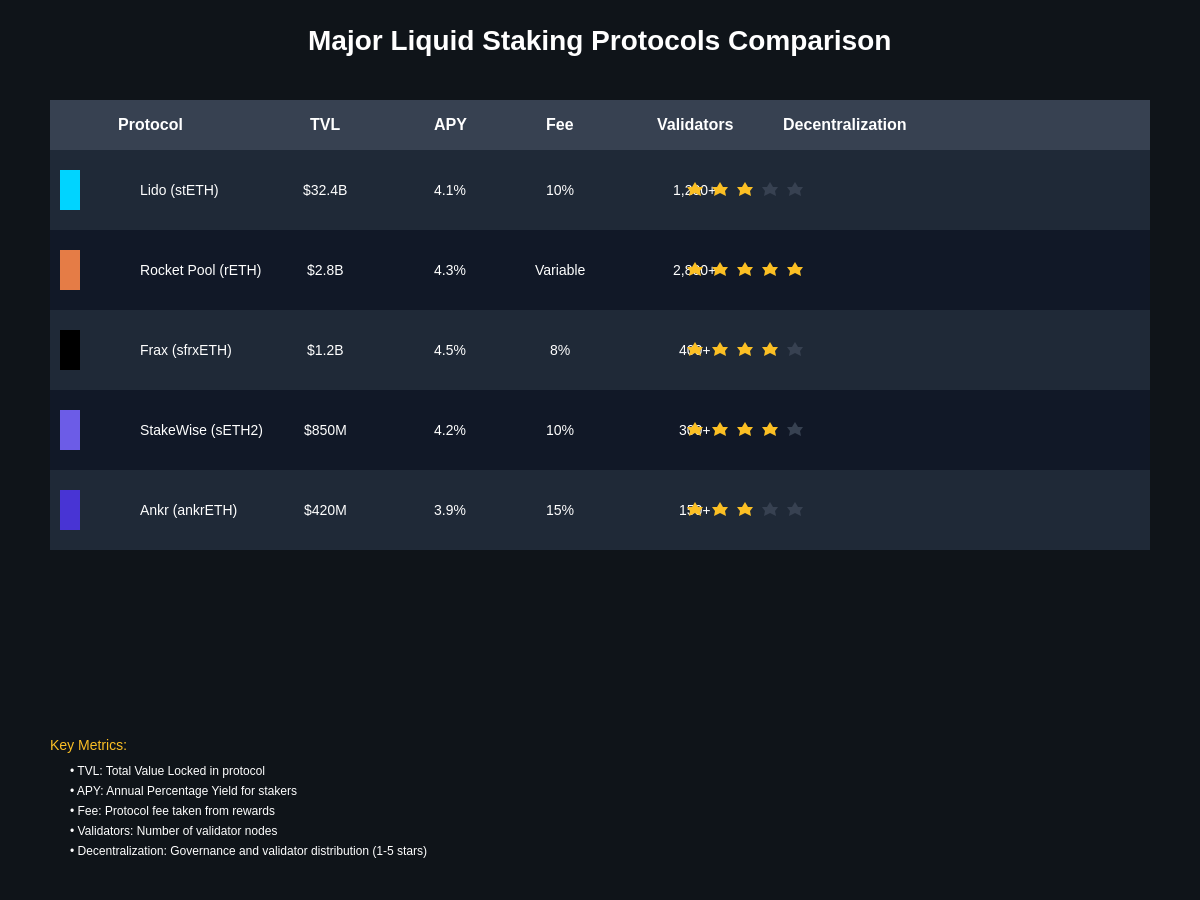
The liquid staking derivative landscape features numerous protocols with varying approaches, risk profiles, and yield optimization strategies. Lido Finance dominates the market with the largest total value locked, offering broad validator distribution and strong liquidity across multiple exchanges and DeFi protocols. Rocket Pool implements a more decentralized approach with permissionless validator participation and a dual-token system that separates governance and yield-bearing functions.
Frax Finance’s liquid staking approach integrates with their broader algorithmic stablecoin ecosystem, offering unique yield optimization opportunities through their protocol-owned liquidity systems. StakeWise provides a more granular approach with separate tokens for staked principal and rewards, allowing users to implement sophisticated tax optimization and yield strategies. Each protocol’s design philosophy and implementation details create distinct risk and return profiles that users should carefully evaluate.
Selection criteria should encompass multiple dimensions including security track record, validator distribution, fee structures, liquidity depth, DeFi integration breadth, and governance mechanisms. Technical factors such as smart contract audit results, formal verification status, and bug bounty programs provide insights into protocol security. Economic factors including total value locked, yield consistency, and fee competitiveness indicate protocol sustainability and user adoption.
Diversification across multiple liquid staking protocols can reduce concentration risk and provide access to different yield optimization strategies. However, this approach increases operational complexity and gas costs while potentially diluting the benefits of protocol-specific optimizations. Users must balance these trade-offs based on their risk tolerance, technical sophistication, and capital allocation requirements.
Market Dynamics and Yield Determinants
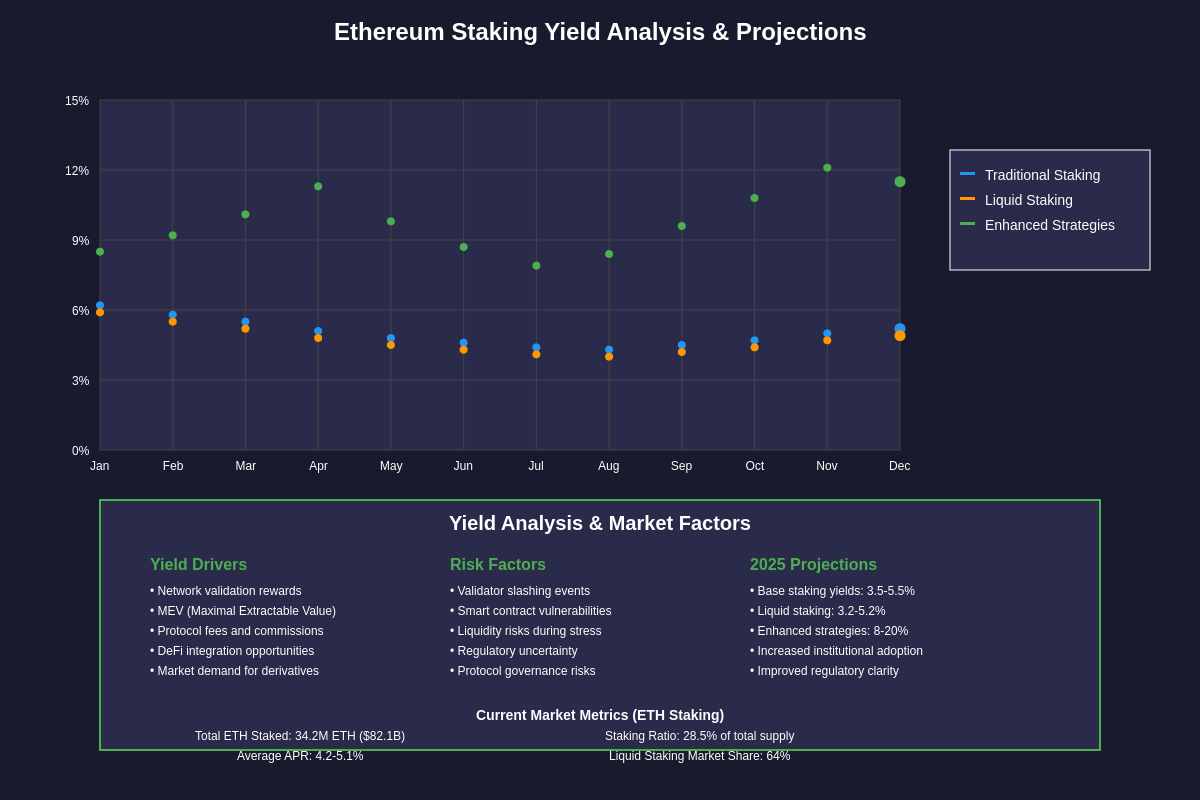
Liquid staking derivative yields are influenced by multiple interconnected factors that create complex market dynamics. Base staking yields form the foundation, determined by network inflation rates, total staking participation, and validator commission structures. These network-level parameters are often subject to governance proposals and protocol upgrades that can significantly impact long-term yield expectations.
Market demand for staking derivatives affects their trading premiums or discounts relative to underlying staked assets. During periods of high demand for liquidity or DeFi participation, derivatives may trade at premiums to their net asset value, providing additional returns for holders. Conversely, during market stress or liquidity crises, derivatives may trade at discounts, creating potential arbitrage opportunities for sophisticated traders.
Protocol-specific factors including fee structures, validator performance, and operational efficiency directly impact net yields delivered to users. Protocols with superior validator selection, lower operational costs, and more efficient reward distribution mechanisms can offer higher net yields to users. Competition among protocols drives innovation in these areas, generally benefiting users through improved services and reduced fees.
External yield opportunities in the broader DeFi ecosystem influence the relative attractiveness of liquid staking derivatives. When alternative yield sources offer significantly higher returns, demand for staking derivatives may decrease, potentially affecting their market premiums and protocol total value locked. Conversely, when alternative yields decline or carry excessive risk, staking derivatives become more attractive as a stable, relatively low-risk yield source.
Advanced Strategies and Institutional Applications
Institutional investors and sophisticated traders employ liquid staking derivatives in complex strategies that leverage their unique characteristics for portfolio optimization and risk management. Delta-neutral strategies combine long positions in staking derivatives with short positions in underlying assets, allowing investors to earn staking yields while hedging price exposure. These strategies are particularly attractive during volatile market periods when maintaining crypto exposure becomes undesirable but staking yields remain attractive.
Carry trade strategies exploit yield differentials between different assets or protocols by borrowing low-yielding assets to purchase higher-yielding staking derivatives. When implemented with appropriate risk management, these strategies can generate attractive risk-adjusted returns while maintaining diversified exposure across multiple crypto assets and protocols.
Cross-chain arbitrage opportunities emerge when liquid staking derivatives trade at different premiums or discounts across various blockchain networks. Sophisticated traders use bridge protocols and cross-chain infrastructure to capitalize on these pricing inefficiencies, though they must carefully manage the additional risks associated with cross-chain operations including bridge security and timing risks.
Institutional applications extend beyond pure yield generation to include treasury management, employee compensation programs, and structured product creation. Companies holding significant crypto treasuries can use liquid staking derivatives to generate yield on idle assets while maintaining operational flexibility. Employee compensation programs can incorporate staking derivatives to provide long-term incentive alignment while allowing employees to access their compensation through liquid markets when needed.
Technology Infrastructure and Scalability Considerations
The technical infrastructure supporting liquid staking derivatives continues to evolve as protocols optimize for scalability, security, and user experience. Layer 2 scaling solutions have become increasingly important as high gas costs on Ethereum mainnet can significantly impact the economic viability of smaller staking positions. Protocols are implementing various scaling approaches including optimistic rollups, zk-rollups, and sidechains to reduce transaction costs and improve accessibility.
Validator infrastructure improvements focus on increasing reliability, reducing slashing risks, and optimizing reward generation. Professional validator operators employ sophisticated monitoring systems, redundant infrastructure, and automated failover mechanisms to maximize uptime and performance. These improvements directly benefit liquid staking derivative holders through more consistent yields and reduced downside risk exposure.
Cross-chain expansion enables liquid staking protocols to support multiple proof-of-stake networks beyond Ethereum, diversifying yield sources and reducing concentration risk. Protocols are developing unified interfaces that allow users to manage staking positions across multiple networks while maintaining simplified user experiences. This expansion also creates opportunities for cross-chain yield optimization and arbitrage strategies.
Interoperability standards and protocols facilitate seamless integration between liquid staking derivatives and other DeFi protocols. Standards like ERC-4626 for tokenized vaults and emerging cross-chain communication protocols enable more efficient and secure interactions between different protocol layers. These improvements reduce integration complexity and enable more sophisticated financial products built on liquid staking foundations.
Regulatory Landscape and Compliance Considerations
The regulatory environment surrounding liquid staking derivatives remains dynamic as authorities worldwide develop frameworks for digital asset staking and derivative instruments. Recent guidance from major jurisdictions has begun clarifying the treatment of staking rewards, validator operations, and derivative token classifications, though significant uncertainty remains in many areas.
Tax implications vary significantly across jurisdictions and can substantially impact the net returns from liquid staking strategies. Some jurisdictions treat staking rewards as income upon receipt, while others defer taxation until disposal. The treatment of derivative tokens, impermanent loss, and protocol fees adds additional complexity that users must navigate to ensure compliance with local tax obligations.
Regulatory developments increasingly focus on validator centralization concerns and the potential systemic risks posed by large liquid staking protocols. Authorities are examining whether dominant protocols could pose risks to blockchain network security and decentralization. These concerns may lead to regulatory requirements for operational diversification, governance structures, or risk management practices.
Compliance frameworks are evolving to address the unique characteristics of liquid staking protocols, including their multi-jurisdictional operations, validator distribution, and token holder rights. Forward-thinking protocols are implementing compliance programs that anticipate regulatory requirements while maintaining their decentralized characteristics and global accessibility.
Future Developments and Innovation Trends
The liquid staking derivative sector continues to innovate rapidly, with emerging developments promising to further enhance the utility and efficiency of these instruments. Automated strategy optimization using machine learning and artificial intelligence is becoming more sophisticated, enabling protocols to dynamically adjust validator selections, yield strategies, and risk parameters based on real-time market conditions and historical performance data.
Intent-based architectures are emerging that allow users to express desired outcomes rather than specific transaction sequences, with automated systems handling the complex execution across multiple protocols and chains. These systems can optimize for various objectives including yield maximization, risk minimization, or liquidity provision while abstracting away the operational complexity from end users.
Privacy-preserving staking solutions are being developed that could enable liquid staking participation while maintaining transaction privacy and reducing regulatory exposure. These solutions leverage zero-knowledge proofs and other cryptographic techniques to provide staking services without revealing user identities or transaction details, potentially expanding access to regions with restrictive regulatory environments.
Synthetic and derivative products built on liquid staking foundations are creating new financial instruments that provide leveraged or inverse exposure to staking yields, enable yield curve trading, and facilitate sophisticated risk management strategies. These products expand the addressable market for liquid staking derivatives beyond direct staking participants to include traditional traders and investors seeking exposure to proof-of-stake yields.
Risk Management and Portfolio Integration
Effective integration of liquid staking derivatives into broader investment portfolios requires careful consideration of correlation patterns, volatility characteristics, and risk-return profiles. While staking derivatives generally exhibit high correlation with their underlying assets, they demonstrate unique behaviors during market stress periods that can impact portfolio performance and risk metrics.
Correlation analysis reveals that liquid staking derivatives typically maintain 0.95+ correlation with underlying assets during normal market conditions but may experience correlation breakdown during extreme events such as protocol exploits, validator slashing incidents, or regulatory announcements. These correlation dynamics have important implications for portfolio risk management and hedging strategies.
Volatility patterns for liquid staking derivatives often exhibit lower realized volatility than underlying assets due to their yield-generating characteristics and institutional adoption. However, they may experience higher volatility during specific events such as protocol upgrades, validator issues, or liquidity crises. Understanding these volatility patterns helps investors optimize position sizing and risk management approaches.
Risk budgeting frameworks should account for the multiple risk factors inherent in liquid staking derivatives including smart contract risk, validator risk, liquidity risk, and correlation risk. Modern portfolio management tools can incorporate these multifaceted risk factors to optimize allocation decisions and ensure appropriate risk-adjusted returns across different market environments.
Operational Considerations and Best Practices
Successful liquid staking derivative implementation requires attention to operational details that can significantly impact net returns and risk exposure. Gas optimization strategies become crucial when frequent interactions with staking protocols are necessary, as transaction costs can materially impact smaller positions. Users should consider batching transactions, timing operations during lower network congestion periods, and utilizing layer 2 solutions where available.
Monitoring and alerting systems help users stay informed about important protocol developments, validator performance changes, and market opportunities. Automated monitoring can track validator performance, protocol yield changes, arbitrage opportunities, and potential risk events, enabling timely responses to changing conditions.
Tax optimization strategies should be implemented from the outset, as retroactive tax planning for complex DeFi strategies can be challenging and potentially costly. Maintaining detailed transaction records, understanding the tax implications of different strategies, and working with qualified tax professionals familiar with digital asset taxation can help optimize after-tax returns.
Security practices remain paramount when interacting with liquid staking protocols and broader DeFi ecosystems. Hardware wallet usage, transaction simulation, smart contract verification, and careful management of private keys and signatures help protect against various attack vectors and user errors that could result in fund loss.
Conclusion and Future Outlook
Liquid staking derivatives represent a fundamental innovation that has resolved the liquidity constraints inherent in traditional proof-of-stake systems while enabling sophisticated yield optimization strategies. As the proof-of-stake ecosystem continues to mature and expand, these instruments are likely to become increasingly important components of the digital asset investment landscape, offering institutional-grade solutions for managing crypto treasuries and optimizing yield generation.
The evolution toward more sophisticated automated strategies, improved cross-chain functionality, and enhanced regulatory clarity promises to further expand the utility and adoption of liquid staking derivatives. Integration with traditional financial systems and the development of regulatory-compliant institutional products could significantly broaden the addressable market and drive continued innovation in this sector.
Professional investors and institutions increasingly recognize liquid staking derivatives as essential tools for digital asset portfolio management, providing stable yield generation capabilities with maintained liquidity and reduced operational complexity. Advanced traders and portfolio managers utilize comprehensive market analysis platforms to model complex liquid staking strategies and optimize their risk-adjusted returns across multiple protocols and market conditions.
The continued development of this sector will likely focus on improving security, reducing risks, enhancing yields, and expanding accessibility while maintaining the decentralized characteristics that make these protocols valuable alternatives to traditional financial systems. As blockchain networks evolve and new proof-of-stake systems emerge, liquid staking derivatives will continue to play a crucial role in maximizing the capital efficiency and utility of staked digital assets.
Disclaimer: This article is for educational and informational purposes only and should not be construed as financial advice. Liquid staking derivatives carry significant risks including smart contract vulnerabilities, validator slashing, liquidity risks, and potential regulatory changes. Cryptocurrency investments are highly volatile and may result in total loss of capital. Always conduct thorough research and consult with qualified financial advisors before making investment decisions. The author and publisher are not responsible for any financial losses that may occur from acting on the information provided in this article.